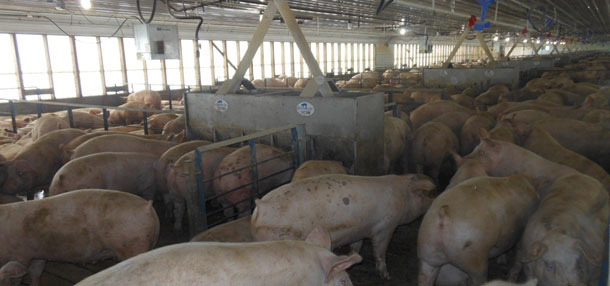The annual increase in slaughter weights for barrows and gilts in the US continues unabated. From 1977 through 2013 the federally inspected dressed slaughter weight for barrows and gilts has increased an average of 0.6 kg (1.3 lb) per year. In 2014 the increase was even larger due to the impact of PEDv on weaned pig numbers and a large reduction in feed cost per unit of gain. While the slaughter year isn’t over at the time of writing this paper, the 2014 yearly average will be somewhere very close to 97.5 kg (214.6 lb) on just over 96 million barrows and gilts.
The impact of space allocation on pig performance is generally well understood. When pigs are grown with less than adequate space per pig, daily feed intake and daily gain are reduced with minimal impact on feed conversion efficiency (Gonyou et al, 2006). Using meta-analysis and published data from a number of experiments Gonyou et al (2006) determined that ‘adequate’ space for growing pigs is defined by the equation:

Area (m2/pig) = 0.034 x (bodyweight, kg)0.667
Area (ft2/pig) = 0.2167 x (bodyweight, lb)0.667
Data is limited regarding the space requirement of pigs grown to heavier final weights. Brumm et al (1996) grew barrows to 136 kg (300 lb) at various space allocations and concluded that the requirement for pigs this heavy was somewhere between 0.84 and 0.93 m2/pig (9 to 10 ft2/pig). Based on the allometric space equation above, the predicted space requirement for pigs at 136 kg (300 lb) is 0.88 m2 (9.55 ft2) per pig, near the mid-point of the Brumm et al (1996) estimate.
Gonyou et al (2006) predicted that for each 3% change in space allocation below the space defined as ‘adequate’, daily gain and daily feed are reduced 1% in fully slatted facilities. This increases to a 1.5% reduction in partially slatted facilities.
In the US, the ‘average’ stocking density in grow-finish facilities is estimated to be in the range of 0.67 m2 (7.2 ft2) per pig (Kliebenstein et al, 2005). Using the 1% reduction in gain for each 3% reduction in space for fully slatted facilities common to the US industry, this stocking density is predicted to reduce gain by a little over 5% overall compared to pigs grown in facilities with adequate space and pens topped (first pig removed for slaughter) when the pen average weight is 113.6 kg (250 lb) (Table 1).
| Average Pen Wt | Requirement | 5% ADG reduction | |||
| kg | lb | m2 | ft2 | m2 | ft2 |
| 109.1 | 240 | 0.78 | 8.38 | 0.66 | 7.12 |
| 113.6 | 250 | 0.80 | 8.61 | 0.68 | 7.32 |
| 118.2 | 260 | 0.82 | 8.84 | 0.70 | 7.52 |
| 122.7 | 270 | 0.84 | 9.07 | 0.71 | 7.71 |
| 127.3 | 280 | 0.86 | 9.29 | 0.73 | 7.90 |
| 131.8 | 290 | 0.79 | 8.51 | 0.75 | 8.09 |
| 136.4 | 300 | 0.90 | 9.73 | 0.77 | 8.27 |
Table 1. Estimated space requirement for un-impacted pig performance and for a 5% reduction in daily gain in fully slatted pens. Based on Gonyou et al (2006).
However, as we grow entire pens of pigs to heavier weights prior to removal of the first pig(s) to slaughter, the impact worsens. For example, if the pen average weight at the time of first pig(s) removal is 125 kg (275 lb) and the stocking density is 0.67 m2 (7.2 ft2)per pig, the overall rate of daily gain during the grow-finish period is estimated to be reduced by 7.2% due to the impact of stocking density.

Figure 1. Pigs housed at 0.67 m2 (7.2 ft2)/pig in large group pens on full slats several weeks prior to removal of first pig to slaughter.

Figure 2. One hundred twenty five head pens just prior to first pig removal for sale to slaughter at approximately 123 kg (271 lb) average pen weight and 0.68 m2 (7.3 ft2) per pig.
All of this suggests that stocking density management becomes more critical as sale weights increase, especially if no adjustment is made in the number of pigs placed into a facility. Because of local, state and national issues dealing with site permitting, producers in the US tend to fill facilities to the permitted number rather than face the difficulties of siting and building additional facilities to allow more space per pig in response to heavier sale weights.
The interaction of heavier weights and space allocation is also evident on pig performance following removal of one or more pigs from a pen for sale to slaughter. While there are few published data sets on the topic, production system experience suggests that the more crowded a pen of pigs is prior to removal of pigs for first sale, the greater the expected increase in daily gain by the remaining pigs in the pen when more space (and other limiting resources) become available.
This highlights the importance of removing one or more pigs from every pen at the time of first sale so that all pens of pigs that remain in the barn have the opportunity for faster growth in response to decreased crowding. Failure to sell from every pen means the pigs in the pens with no sale pig removal become increasingly crowded and feed intake and gain become even more depressed, adding to the variation in pig performance in the facility.




